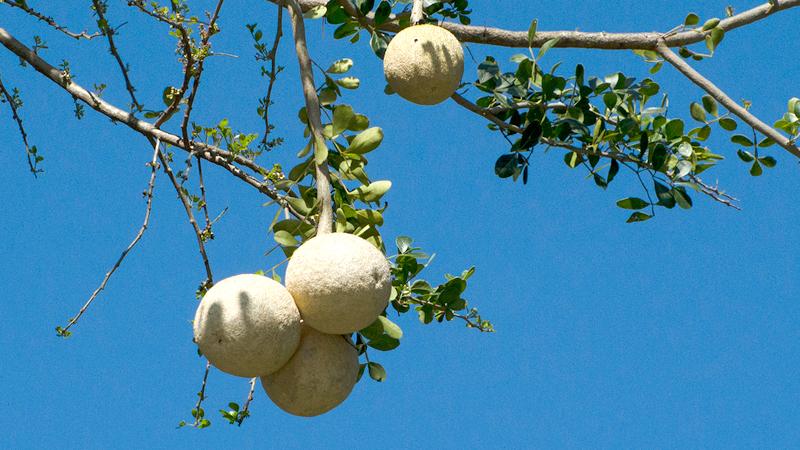
The beginning and end of the year is the time when the wood-apple tree (Limoniaacidissima; also Feroniaelephantum) is in fruit. In Sinhala, we call this tree divul
Actually, my own search for wood-apple, or divul, this season, was driven by nostalgia; I am not a fan of the fruit. However, during my past journeys to many destinations in the dry zone, I came across ubiquitous divul sellers at wayside stalls selling an abundance of divul. Now, spending time at home with the coronovirus lockdown, I decided to write a piece on divul, which was my long-cherished idea with pictures captured by me in various places.
During all seasons, when the wild wood-apple trees are laden with fruits, it is not an uncommon sight in any part of the dry-zone, to see jungle folk gathering wood-apples in gunny bags, for sale. This, they do at some suitable spot off the roadside, near one or more of the forest villages, like those in the Vakaneri-Punanai area in Batticaloa North. These fruits are also plentiful in the jungle-regions on the way to Vakarai and Kathiraveli.
The fruits, which are plucked with some difficulty from the spiny trees, are sold cheap to middlemen according to size and condition. However, in the markets and bazaars of the adjoining villages like Valachchenai, they fetch double the price or more according to the demand. During the off-season, the prices are even higher.
The wood-apple tree, which can grow to a height of about 30 to 40 feet, is common in the low-country dry-zone of Sri Lanka, and is found in India, Pakistan and Indonesia. It is related to the orange family, and the spices are closely allied also to trees like the Bael (Beli) or slime-apple.
The divul tree’s bark, leaves, wood and roots provide native physicians with a wealth of medicinal ingredients. While various parts of the wood-apple tree have their uses, it is to the fruit that special reference is being made here.
The ripe fruit, which is aromatic and is about 2 ½ to 3 inches in diameter, resembles a cricket or tennis ball in size. It is spherical, hard, grey and woody-with a scurfy skin and has a mass of soft but acidic pulp, with numerous seeds embedded within.
This pulp, which is edible, is also highly relished by wild elephants. In fact, in our dry-zone jungles around the lower Mahaweli basin, wood-apple is the favourite food of the ‘marsh’ elephants.
Mixed with treacle, sugar, jaggery or any other sweet substance, the pulp (after the seeds have been removed) also forms an excellent dessert. A kind of preserve, jelly or chutney is also made from the pulp, and this is said to stimulate an appetite. And don’t be surprised if your breakfast scones come with divul jam.
Though the fruit -pulp is astringent, it is used for making a pleasant, cooling drink - a kind of sherbet – which is very refreshing. The recipe for the preparation of the drink (according to ‘Wijaya food recipe book’ published in Sinhala, first edition-2000) is as follows: -
“Take six wood-apples, 1 coconut and some jaggery; scrape out the inside of the wood-apples; squash the pulp well and strain through a sieve; break the coconut into two, scrape out the milk; mix some of it through the sieve; scrape the jaggery finely with a knife, and add to the liquid according to taste; add the rest of the coconut milk till the drink becomes as thin as desired.”
It is said that, in some parts of India, the woody shell is converted into fancy articles like snuff-boxes, ash-trays, trinket-boxes and a variety of similar items.
But, apart from these uses, the green fruit, mixed with honey, is used medicinally by ayurvedic physicians as a remedy for diarrhoea, acute and chronic dysentery and other stomach disorders. The pulp of the ripe fruit is also administered for ailments of the mouth. It is also used to treat afflictions of the gums, hiccup and sore-throat, for promoting salivation, and for preventing difficulty in breathing.
It is also said that, externally, the fruit pulp is used (in certain countries like India) as a salve for bites, and stings of insects like bees and wasps. Divul is also regarded as an antidote against animal-poisons. It is also used in cases of bites by venomous snakes and other poisonous creatures, after the pulp has been mixed (as in India) with honey or cane-sugar in equal parts, and administered as a drink. The pulp of the fresh fruit is also applied to the part which has been bitten.
Such are the various uses – in medicine, dietary and other fields – of the wood-apples which are collected from our Sri Lankan gardens and wild areas.

